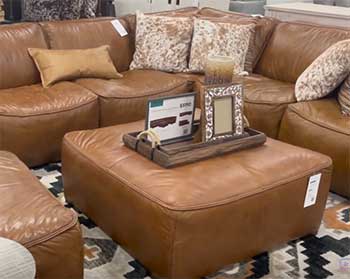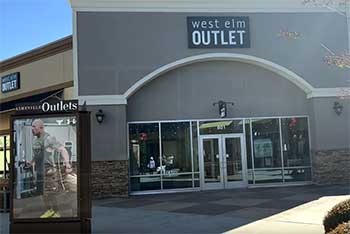When it comes to furnishing your home, two popular retailers known for their modern designs and affordable prices are Living Spaces and West Elm. Both offer a wide selection of stylish furniture and home decor items.
However, there are some key differences between these two brands that are worth considering when deciding where to shop.
A Brief Comparison Table
| Features | Living Spaces | West Elm |
| Pricing | Very affordable, lowest pricing of the two | Mid-tier pricing, pricier than Living Spaces |
| Quality | Lower quality materials like particleboard, but minimal flaws | Better quality materials like solid woods |
| Construction | Less durable but looks great for the cost | Careful attention to seamwork and finishing |
| Style | Relaxed contemporary using muted neutrals and subtle pops of color | Bold global designs with lots of patterns, textures, and accent colors |
| Original Designs | Some exclusives but mostly sells existing manufacturer collections | Large in-house team designing most products in-house |
| Inventory | Furniture and decor for all rooms | Expansive lifestyle range including bedding, bath, kitchen, lighting, rugs, and more |
| Company | Founded 2003 in California, over 60 locations | Founded 2003 in Brooklyn, over 100 locations worldwide |
| Collaboration | Minimal collaborations | Frequent collaborations with artists, influencers on unique limited collections |
| Customization | Upholstery available in different fabrics/colors | Wider range of customizable upholstery lines and furniture |
| Ethics | Responsible sourcing and supply chain transparency | Commitment to sustainable materials and ethical manufacturing |
Overview Of Living Spaces
Founded in 2003 and headquartered in California, Living Spaces aims to provide quality furniture at approachable price points. Their style blends mid-century and contemporary design elements for a relaxed yet refined aesthetic. You’ll find a full range of furniture for every room of the house including sofas, sectionals, dining sets, coffee tables, bedroom sets, rugs, lighting, and home accents.

They also have an in-house design team that creates exclusive products only available at Living Spaces. This includes customizable upholstery where you can choose from dozens of fabric and color options to make pieces your own.
Living Spaces has over 60 showroom locations across the U.S. primarily located in Arizona, California, Nevada, Washington, Oregon, Florida, and Texas. They offer free in-home design services to help visualize pieces in your space.
To keep costs low, Living Spaces maintains a lower profit margin and purchases in high volume directly from manufacturers. They’re able to pass the savings directly on to consumers.
Overview Of West Elm
Founded in Brooklyn, NY in 2003 and now owned by Williams-Sonoma Inc., West Elm has grown to over 100 locations worldwide. They are known for their modern-boho style blending sleek forms with natural materials and global influence.

West Elm’s product range includes furniture, bedding, bath, kitchen and dining, lighting, rugs, decor, and more – everything you need to outfit a home top to bottom.
While West Elm does work with external designers, they have a large in-house design team that allows them to quickly adapt to new trends. They release fresh collections on a monthly basis and often collaborate with artists, bloggers, celebrities, and influencers on limited-edition collections.
This produces unique, exclusive items you won’t find elsewhere. West Elm also operates five hotels that showcase their signature home furnishings and design aesthetic.
Living Spaces And West Elm: In-Depth Comparison Of Key Features
Quality and Construction
When it comes to quality and durability, both West Elm and Living Spaces offer pieces with style and function in mind. However, there are some differences.
Living Spaces tends to use more affordable materials like particleboard, engineered woods, and bonded leather in their furniture construction. But they focus on minimizing flaws and defects so pieces still look great.
This ensures lower costs that they pass onto customers. While durability may be moderate, their items are very affordable for the stylish designs.
West Elm uses slightly higher quality materials like solid wood, aniline dyed leather, performance fabrics, and top grain leather. Attention is paid to seamwork and finishing. Products are designed to last through everyday wear and tear with careful craftsmanship. But the improved quality comes at a higher price point.
So if your budget is tight but you want trendy styles, Living Spaces is a great affordable option. For small splurges on signature items built to last, West Elm may be worth the extra expense.
Styles and Aesthetics
When it comes to home decor styles, both retailers cater to modern sensibilities. But there are some visible differences in their specific aesthetics.
Living Spaces has a relaxed contemporary vibe. Their typical color palette includes muted neutrals accented with pops of color in pillows, rugs, and decor items. Silhouettes tend to be simple and unfussy, often with sloped arms, tapered legs, and low profiles.
You’ll see lots of solid fabrics and vegan leather along with medium tone woods. It’s a pared-back look that’s inviting without being overly soft.
West Elm has a more distinctly modern and globally-inspired design. Their color palette varies from earthy neutrals to bold accent colors drawing from textile traditions worldwide. Silhouettes range from architectural and angular to curved organic shapes with delicate details.
Many pieces incorporate natural and reclaimed materials like rattan, jute, acacia wood and eclectic patterns. The overall look feels cosmopolitan and fashion-forward.
So Living Spaces caters more to fans of subdued contemporary pieces while West Elm targets those who gravitate toward striking global-chic designs with detailed craftsmanship. Both have sleek modern appeal but showcase their styles differently.
Also Read: Comparison Between Poly & Bark And Joybird.
Affordability and Pricing
When comparing affordability, Living Spaces comes out on top with lower everyday pricing across the board. Here are some examples to illustrate the typical price differences:
- Sofas: Living Spaces sofas range from $499 to $1699 for leather and fabric options in various styles. West Elm sofas range from $999 to $3599 with most over $1500.
- Coffee Tables: You can find coffee tables for as low as $99 at Living Spaces, with most under $600. West Elm’s coffee table selection starts around $399 and goes over $1000.
- Dining Sets: Living Spaces dining sets start at just $299 for a table and chairs. At West Elm, sets start at the $800 range.
- Bedroom Furniture: A queen bed is around $599 at Living Spaces while West Elm’s start at $899. A simple six-drawer dresser is under $300 at Living Spaces versus $500 and up for similar at West Elm.
While both brands offer sales, Living Spaces has lower regular retail prices across comparable items. This makes them generally more budget-friendly for the style. West Elm’s regular prices are a definite step up.
But for signature pieces where quality is worth the splurge, they make a worthwhile investment.
Frequently Asked Questions (FAQ)
Some of West Elm’s biggest competitors in the modern furniture and home decor space include:
CB2 – Offers a similar modern-bohemian aesthetic at competitive price points. Owned by Crate & Barrel.
Article – Direct-to-consumer furniture company with a minimalist-chic style.
Joybird – Known for mid-century and contemporary-inspired customizable furniture.
Anthropologie – Curation of globally-sourced furniture and decor with boho flair.
Ikea – Affordable prices though lower quality than West Elm. More basic modern minimalist designs.
Blu Dot – Retailer specializing in sleek, high-quality contemporary furniture.
Room & Board – Wide range of contemporary-to-modern styles focused on quality craftsmanship.
West Elm falls more into the mid-tier price point range rather than high end or luxury. It is priced above big box stores like Target and Ikea. However, West Elm is more affordable than premium designer furniture from true high end brands. Within the Williams-Sonoma brand portfolio, West Elm is positioned below Pottery Barn in terms of pricing. While not cheap, West Elm seeks to offer stylish furniture accessible to a broader audience.
Amazon’s Rivet brand offers furniture and decor with a modern aesthetic and pricing that is comparable to West Elm. Like West Elm, Rivet focuses on contemporary silhouettes and materials like stainless steel, velvet, and leather. Their product range includes sofas, beds, lighting, rugs, tables, and home accessories with lots of minimalist and mid-century inspired design. The quality is slightly lower than West Elm but the affordable pricing matches up.
There are a few key things that make West Elm stand out:
In-house design team that produces original, exclusive pieces not available anywhere else. New collections launch monthly so there is always something new.
Globally inspired and eclectic style blending modern, bohemian, mid-century, and Scandinavian design. Lots of handcrafted accents and natural materials.
Frequent collaborations with artists, bloggers, influencers, and celebrities on limited edition collections yield unique items.
Range of customization options available for upholstery and certain furniture lines so you can make pieces your own.
Multi-functional and space-saving designs that are great for small spaces. Convertible furnishings that effortlessly switch functions.
Commitment to responsible production and ethical manufacturing standards for sustainability and social good.
West Elm Hotels showcase the brand’s signature style in a fully-designed hospitality atmosphere.
Watch the video of Living Spaces!
The Verdict
So when determining which retailer is better suited for you, it depends on a few factors:
- Budget – If keeping costs low is your main priority, Living Spaces provides stylish options at more affordable everyday price points.
- Quality – For higher quality materials and construction, West Elm is the way to go especially for key investment pieces.
- Style – For a relaxed contemporary look in muted tones, Living Spaces fits the bill. For globally inspired statement pieces, West Elm has more flair.
- Inventory – Living Spaces focuses specifically on furniture and decor. West Elm has a wider assortment including bedding, bath, kitchenware, and more lifestyle products.
There are situations where either could be a better fit. Living Spaces wins on budget-friendly pricing for an entire room makeover. West Elm excels at curated pieces with interesting details that give a personal touch over time.
Also Read: Comparison Between Wayfair And West Elm.
Combining items from both retailers is also a smart strategy to maximize style and savings.
No matter which brand you choose, think about which qualities matter most for your home furnishings. Determine what pieces you want to invest more in for the long haul.
Then you can find the right balance between affordability and design at Living Spaces and West Elm.
So from trend-driven in-house designs to small space solutions and customized options, West Elm differentiates itself as a go-to source for contemporary furniture with a global view.
The collaborative partnerships, space-saving ethos, and focus on ethics also attract today’s conscious consumers.

